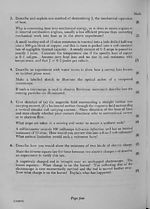Download files
Complete book:
Individual page:
Thumbnail gallery: Grid view | List view

9. Explain how, on the kinetic model, change of state can be effected without change in
temperature, although it is a common observation that a rapidly evaporating liquid
suffers a consequent drop in temperature.
10. How could you, by electrical tests, identify the two electrodes of a diode valve?
Explain.
11. Name two regions within the electro-magnetic spectrum but outside the visible range
easily studied in the school laboratory. Make a labelled sketch showing how you
would verify the law of reflection within one of these regions.
12. Describe briefly a sensitive form of electroscope which could be used to compare the
strengths of two radium sources.
SECTION 2
Candidates are advised to spend about 1| hours on this
section. Only THREE questions should be attempted
from this section. Each question carries 18 marks.
Diagrams of apparatus should be drawn wherever
appropriate.
!■ State the principle of the conservation of momentum.
Describe and explain a method of verifying this principle by experiment.
A billiard ball of mass 100 gm moving at a steady 10 cm per sec hits a second
equal but stationary ball head on.
If no kinetic energy is lost in the collision, wdiat happens to each ball?
In practice perhaps one-quarter of the original kinetic energy would be lost in
the collision. Express this fact as an equation using the symbols V and W for
the final velocities of the first and second balls—but do not solve.
Marks
(3)
(7)
(4)
(4)
tst three different physical effects which show that matter is very fine¬
grained or alternatively continuously divisible. Next describe in detail one
experiment that suggests that there is a limit to the extent to which matter can
be divided.
Gben that Avogadro’s number is 6 X 1023 and that the gram-molecular
'o ume of any gas at N.T.P. occupies 22-4 litres, calculate the average distance
e "een the centres of the gas molecules under these conditions.
speedC?n t^e ^aS Pressure aPPear to be constant if the molecules have different
(9)
(7)
(2)
Page three
temperature, although it is a common observation that a rapidly evaporating liquid
suffers a consequent drop in temperature.
10. How could you, by electrical tests, identify the two electrodes of a diode valve?
Explain.
11. Name two regions within the electro-magnetic spectrum but outside the visible range
easily studied in the school laboratory. Make a labelled sketch showing how you
would verify the law of reflection within one of these regions.
12. Describe briefly a sensitive form of electroscope which could be used to compare the
strengths of two radium sources.
SECTION 2
Candidates are advised to spend about 1| hours on this
section. Only THREE questions should be attempted
from this section. Each question carries 18 marks.
Diagrams of apparatus should be drawn wherever
appropriate.
!■ State the principle of the conservation of momentum.
Describe and explain a method of verifying this principle by experiment.
A billiard ball of mass 100 gm moving at a steady 10 cm per sec hits a second
equal but stationary ball head on.
If no kinetic energy is lost in the collision, wdiat happens to each ball?
In practice perhaps one-quarter of the original kinetic energy would be lost in
the collision. Express this fact as an equation using the symbols V and W for
the final velocities of the first and second balls—but do not solve.
Marks
(3)
(7)
(4)
(4)
tst three different physical effects which show that matter is very fine¬
grained or alternatively continuously divisible. Next describe in detail one
experiment that suggests that there is a limit to the extent to which matter can
be divided.
Gben that Avogadro’s number is 6 X 1023 and that the gram-molecular
'o ume of any gas at N.T.P. occupies 22-4 litres, calculate the average distance
e "een the centres of the gas molecules under these conditions.
speedC?n t^e ^aS Pressure aPPear to be constant if the molecules have different
(9)
(7)
(2)
Page three
Set display mode to:
![]() Universal Viewer |
Universal Viewer | ![]() Mirador |
Large image | Transcription
Mirador |
Large image | Transcription
Images and transcriptions on this page, including medium image downloads, may be used under the Creative Commons Attribution 4.0 International Licence unless otherwise stated. ![]()
| Scottish school exams and circulars > Scottish Certificate of Education > 1963 > (385) |
|---|
| Permanent URL | https://digital.nls.uk/130803752 |
|---|
| Attribution and copyright: |
|
|---|---|
| Shelfmark | GEB.16 |
|---|---|
| Additional NLS resources: | |
| Description | Examination papers for the School Leaving Certificate 1888-1961 and the Scottish Certificate of Education 1962-1963. Produced by the Scotch (later 'Scottish') Education Department, these exam papers show how education developed in Scotland over this period, with a growing choice of subjects. Comparing them with current exam papers, there are obvious differences in the content and standards of the questions, and also in the layout and use of language |
|---|---|
| Additional NLS resources: |
|



